Synchronized music of Zub (Amstrad CPC and C64) by John Gage
-A new video by John Gage : synchronized music of Zub (Mastertronic in 1987) on Amstrad CPC (AY in stereo) and C64 (SID in mono).
The original music is written by David Whittaker.
A new video by John Gage : synchronized music of Zub (Mastertronic in 1987) on Amstrad CPC (AY in stereo) and C64 (SID in mono).
The original music is written by David Whittaker.
A new video by John Gage : synchronized music of Beverly Hills cop on Amstrad CPC (AY in stereo) and C64 (SID in mono).
The original music is written by David Whittaker.
A new video by ChinnyVision on Youtube about Advanced Pinball Simulator is available. This pinball game was out on Amstrad CPC in 1988 by Codemasters.
He also tests it on Spectrum, C64 and Atari XL/XE.
The MIST is a Field-programmable gate array (FGPA) board designed to implement classic 16 bit computers like the Amiga and Atari ST(E) as System-on-a-Chip using modern hardware. But it equally well supports 8 bit systems like the Atari XL, ZX81, ZX Spectrum, C64, Atari VCS, Atari 5200, Colecovision, Apple II, Sega Master System, NES, Odyssey2 and of course the Amstrad CPC.
Renaud Helias has written an Amstrad CPC 6128 core for this Mist Board. The last revision of this core can run correctly the Still Rising demo by Vanity (see the youtube video).
Shame on me, I didnt have yet written about the C4CPC which is for the Amstrad CPC+ and GX4000 cartridge port what the HxC drive emulator was for the disk drive. It is created by Gerald.
BEWARE, using the C4CPC with a GX4000 console and its original alimentation will give you a nice clipboard, for the explanation, it's here.
And of course, with 3D printing, some people went for it to make a C4CPC cartridge with a better look :
Nocart v1.4 for windows will let you convert Amstrad CPC programs in a .CPR file (cartridge image) usable on the C4CPC. Beware, some programs wont work : the keyboard will not work, it means the game must be patched for CPC+ firmware.
And now the next part by Nostalgia Nerd : Amstrad CPC story part 2.
Thanks to TuYaTroJoueY on Twitter, a youtube video by Nostalgia Nerd : Amstrad CPC story part 1.
Go at 10 minutes and 30 seconds for the part about the Amstrad CPC, but the beginning is interesting.
Les Crackers Velus scanned the labels of different brands of Amstrad CPC disks, 3 inch of course. In this pack, there should be at least one who will give you a happy flash back.
Thanks to them.
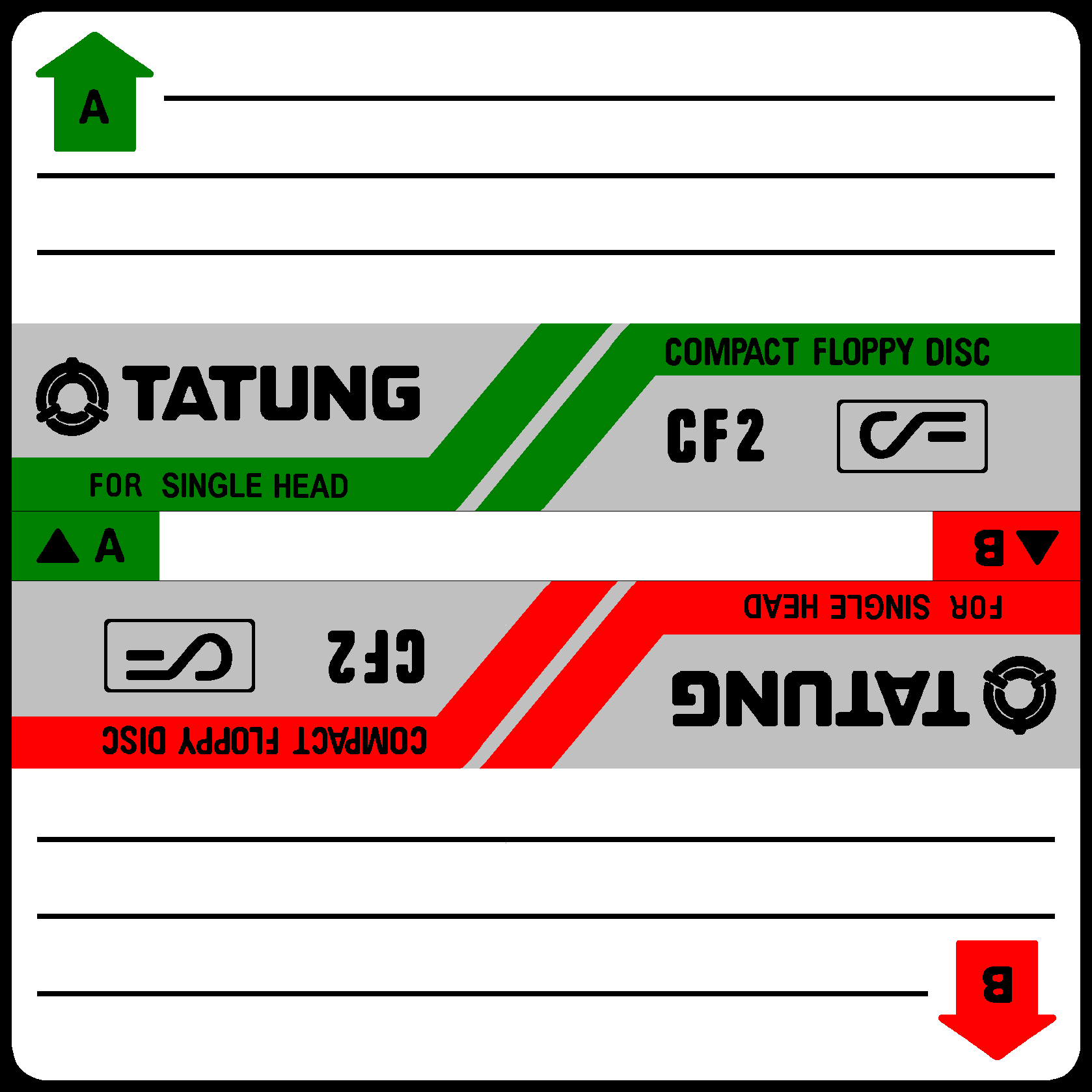
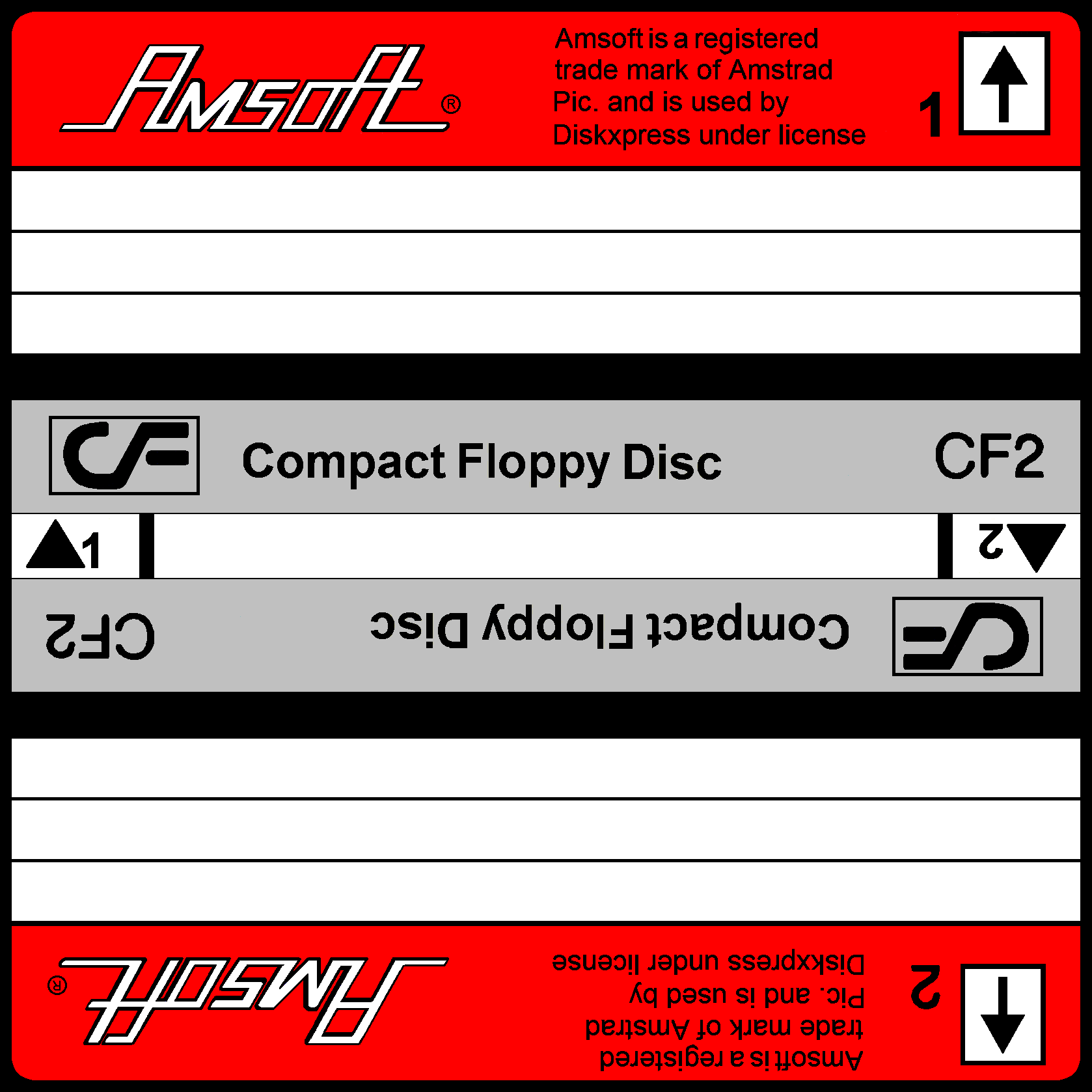

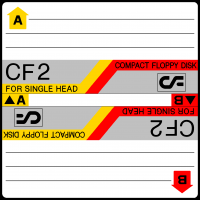
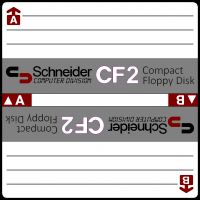
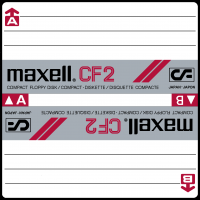
El Linaje Real is the next and first Amstrad CPC game for the 2017 year by ESP Soft.
It's a platform game with 5 levels which should be availabe for April 2017. The game is finished already and being tested. You will test your sword skill in this game, by foot, by horse, by boat. And there wont be only one way to end the game.
Xyphoe is back with a new longplay of Power Drift on Amstrad CPC (part 1 of 2).
Power Drift is a car race game by Sega, edited on Amstrad CPC by Activision in 1989.
JB Le Daron is a french Youtube channel I just jumped on. In this fist episode, he is talking about speedrun : finish a game as fast as possible, often seen on other 8bit computers and consoles, but rarely (or never) on Amstrad CPC to my knowing. And it's Barbarian by Palace Software in 1987 which you will see done quickly.
After having seen the video, there should be on CPC-Power that you should know some SNR files which are played games (speedrun or not) which you can read with the emulator WinAPE.
Will you be able to beat the game Barbarian in less than 6 minutes and 12 seconds, the record made by Kukulcan (CPC-Power) ? The speedrun starts at 6 minutes in the video.
After having listened to the musical remakes of Geovarius on Soundcloud, it's time to see him playing Saboteur 2 on his keytar (keyboard guitar) starting at 8 minutes and 5 seconds.
A remake of the music of Airwolf II (Elite in 1987) by Geovarius on Soundcloud is available.
New version of the Amstrad CPC core for MiST by Renaud Helias is available.
quick : Arkanoid II, Prehistoric II. Ecole demo. Pinball Dreams
slow : Saboteur 2. Still Rising demo.
A remake of the music of Saboteur II by Geovarius on Soundcloud is available. Sometimes when you look for the words 'Amstrad CPC' on a search engine, you find things.
_1.png)
Amstrad Eterno 2017 es un evento de Amstrad CPC en Barcelona (España), el 18 de marzo de 2017.
Amstrad Eterno 2017 is an Amstrad CPC event in Barcelone (Spain) on the 18th March 2017.
See also the Amstrad Eterno Facebook page.
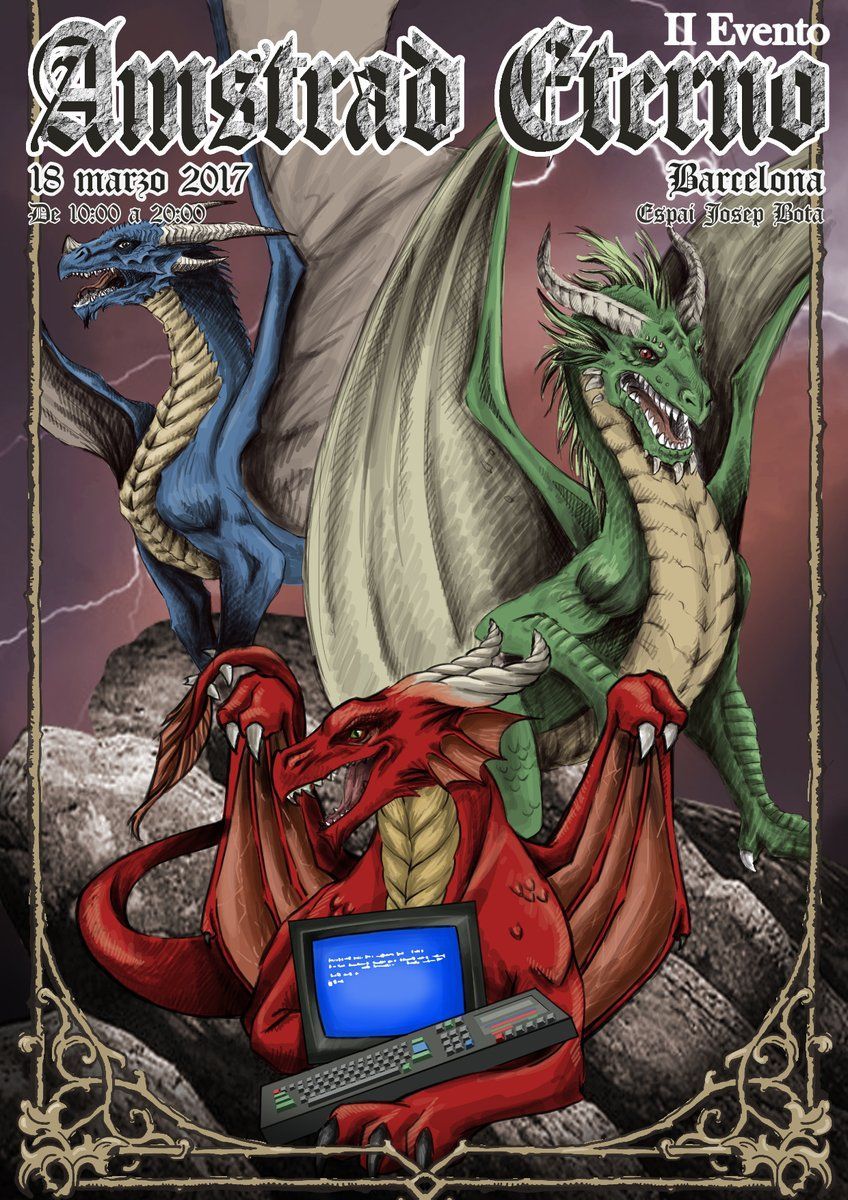
Vasm v1.7h is a compilator for several platforms :
And of course, it can compile Z80 assembler, but it's not the only processor it can manage.
The RetroGaming Play 2017 will take place in France at Meaux (77) this week-end the 18th and 19th February 2017.
This event is all about video game culture, it will feature expositions, Freeplay, animations, arcade games, quizz contests, selling booth, conferences...
Will be present : Bertrand Brocard, AHL, Florent Gorges, Douglas Alves ou bien Abrial Da Costa (more guests normally expected) and also Youtubers : Keydee, AtOmium et Psychodélik.
Another Youtube channel : Khomenor, like ChinnyVision he tests games, but not only the Amstrad CPC version. For Contrat / Gryzor, it was written only on 8bit computers/consoles, no 16bit.
For once ChinnyVision doesnt test an Amstrad CPC game, but some Amstrad hardware : the Amstrad PenPad PDA600, a personal assistant which was able to recognize hand made writing with his Z180 processor.
Tomorrow, he will test an Amstrad Notepad NC100.
4Mhz posted 4 pictures of El Tesoro Perdido de Cuauhtemoc on Twitter (the lost treasure of Cuauhtemoc), their latest work in progress Amstrad CPC game (platform).
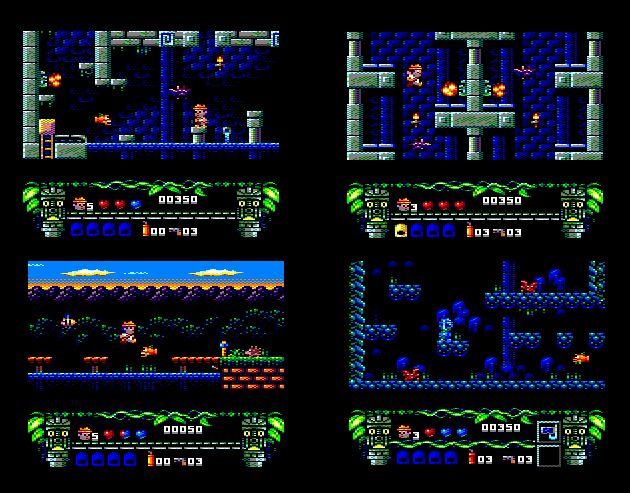
If you want to check the inside of an Amstrad notepad NC200 being repaired by Serge. it's here.
A past news was about an Amstrad Notepad NC100 being repaired by EEVblog.
Another hardware test by ChinnyVision about the Amstrad NC100 Notepad Computer sold in 1992, an interesting portable computer, which existed also for the french and italian market as the Notepad NC150, and a later model the Notepad NC200 with a disk drive (1993).
The Amstrad Notepad NC100 has a Zilog Z80 processor like the Amstrad CPC and PCW, 64 Kb of RAM, a RS232C serial port, printer port, PCMCIA port to add a memory card (1 Mb maximum). The LCD screen has 8 rows of 80 characters (480 x 64 pixels). Used with 4 AA cell batteries, the NC100 can run for about 20 hours. The english manual of the Notepad NC100 is available for download.
Its features are :
The Amstrad notepad NC100 can be used with the original interface/OS or with ZCN by Mark Russel wich is a native CP/M, or with Fuzix which is an unix (system 5) by Alan Cox.
You can emulate an Amstrad NC100 (and also NC150 and NC200) with nc100em (still by Mark Russel) for linux or ms-dos and a windows (port by Stefano Bodrato). The MESS emulator also supports the 3 Amstrad notepad NC. If you dont have the original NC100 ROM, you will need the ZCN.BIN file included in ZCN v1.3.
You will find more informations about the Amstrad Notepad NC on the excellent Tim's Amstrad NC users site where you will find programs for your NC100, see also the ZCN page.
Others youttube videos about Amstrad Notepad NC computers :
West Bank is a spanish arcade Amstrad CPC game released in 1986 by Dinamic Software. An english version was released by Gremlins Graphics in 1987. Three doors in front if you, will you be fast enough to shoot the desesperados without harming innocents ?
I just found on Sourceforge a windows remake : FitoWestBank by Adolfito. I missed the announcement on CPCWiki (see source below).
.png)
The last video of JB le Daron is about Gryzor and Barbarian, so I wont't show it as it was already the subject the last few days of a video by Khomenor and Daron himself for the first one I showed of him.
But in the one before the last the Daron shows 3 games : Picrocs (BDCIron), Virusdog (Kukulcan) at 12:10 and Vector Vaults (Alberto) at 35:10 released for the CPCRetroDev 2016.
Antibug did compile again his Sorcery+ remake for windows XP to 10. It has the original graphics.
You will find on his page the complete solution in JPG or PDF format.
A video of the Amstrad CPC game Captain Sevilla (Dinamic Software in 1988) sur Youtube par Retro Danuart.
With the permission of CE (without asci characters), here is the copy and paste of a message on CPCWiki about repairing an Amstrad NC200 with a lot of photos. Thanks CE.
I want also to thank all the writers and readers of the Amstrad forums I go (CPCwiki, CPCRUlez, Amstrad.ES, Amstrad.EU, etc...), Youtube users for their videos, those who write programs for our beloved Amstrad computers, or who make hardware for them. Without you all this site wouldnt exist (or would be really empty). Thank you all for making Amstrad computers still live more than 30 years after the CPC was created.
Below you can see the computer when I received it. It seems that in 1997 it was brought to some sort of technical service because the space bar was not working anymore. In there, they said that it was not possible to repair it and the NC200 went back to its owner. It was probably laying around since then, until they decided to get rid of it. I know that many of these machines were actually not used very often, but this is not the case. Whoever had it first worked with the laptop a lot: you can see marks here and there and a few shiny keys.
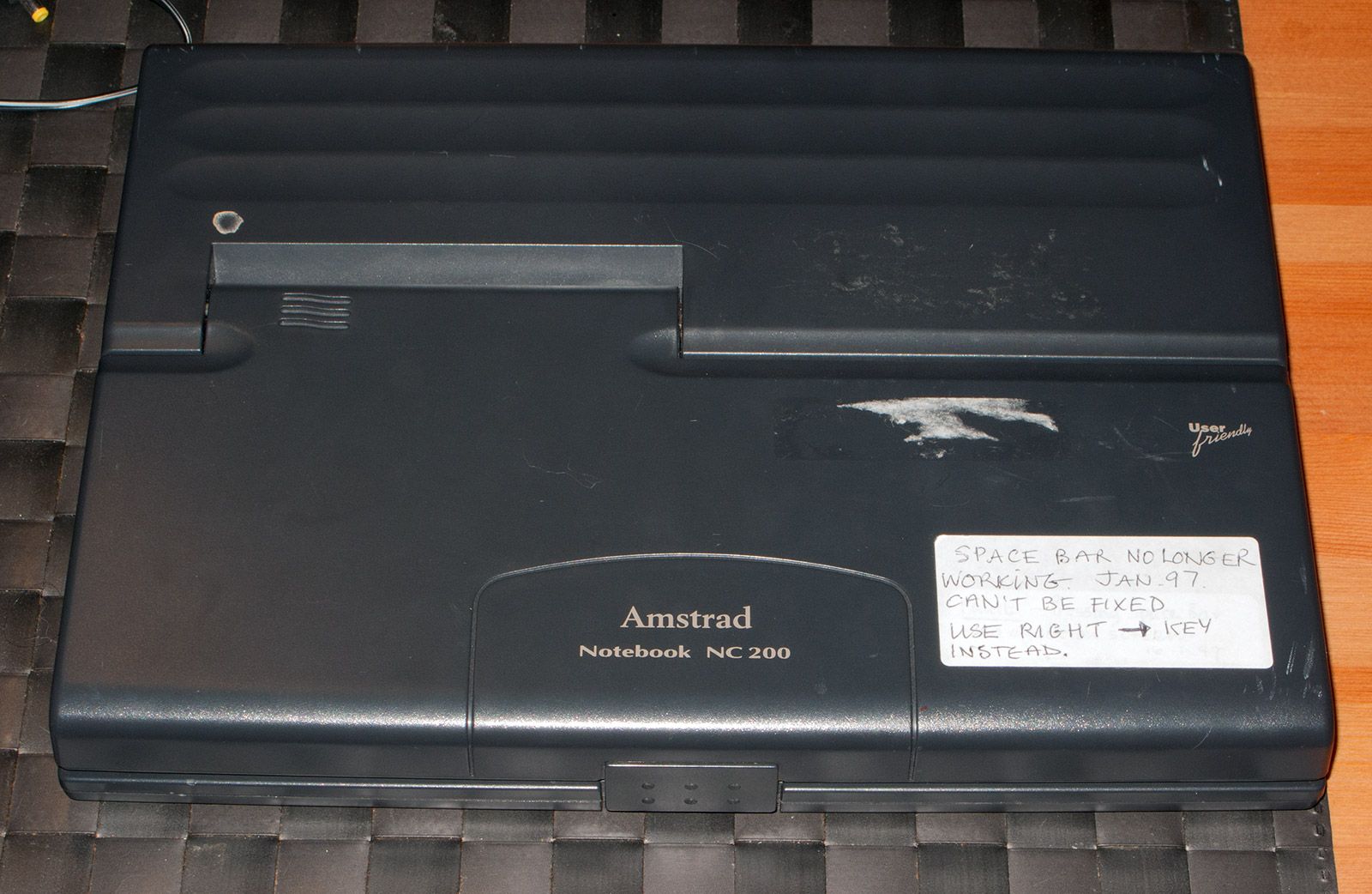

The first thing I did was to power it on and check that, as the seller said, the keyboard was actually not working properly. The display was fine besides the backlight, that turned out to be extremely dim. There was also a decent layer of crap covering it.
The second thing was to disassemble the machine. It is quite easy. You have 5 screws on the bottom and a few clips on the keyboard region. Take the screws first and then lift the case a little bit in a careful way. The clips from the keyboard can be released introducing a little plastic sheet in the gap between the two shells and moving it around, or even with your fingers. In any case, be careful not to damage the case around the keyboard, this computer had been opened in the past in a very clumsy way and there was already a small crack that I had to repair with epoxy resin (more of this at the end). You can see four of the five screws to be removed in the next image. The last one is inside the battery compartment. They have different sizes, remember their original position.
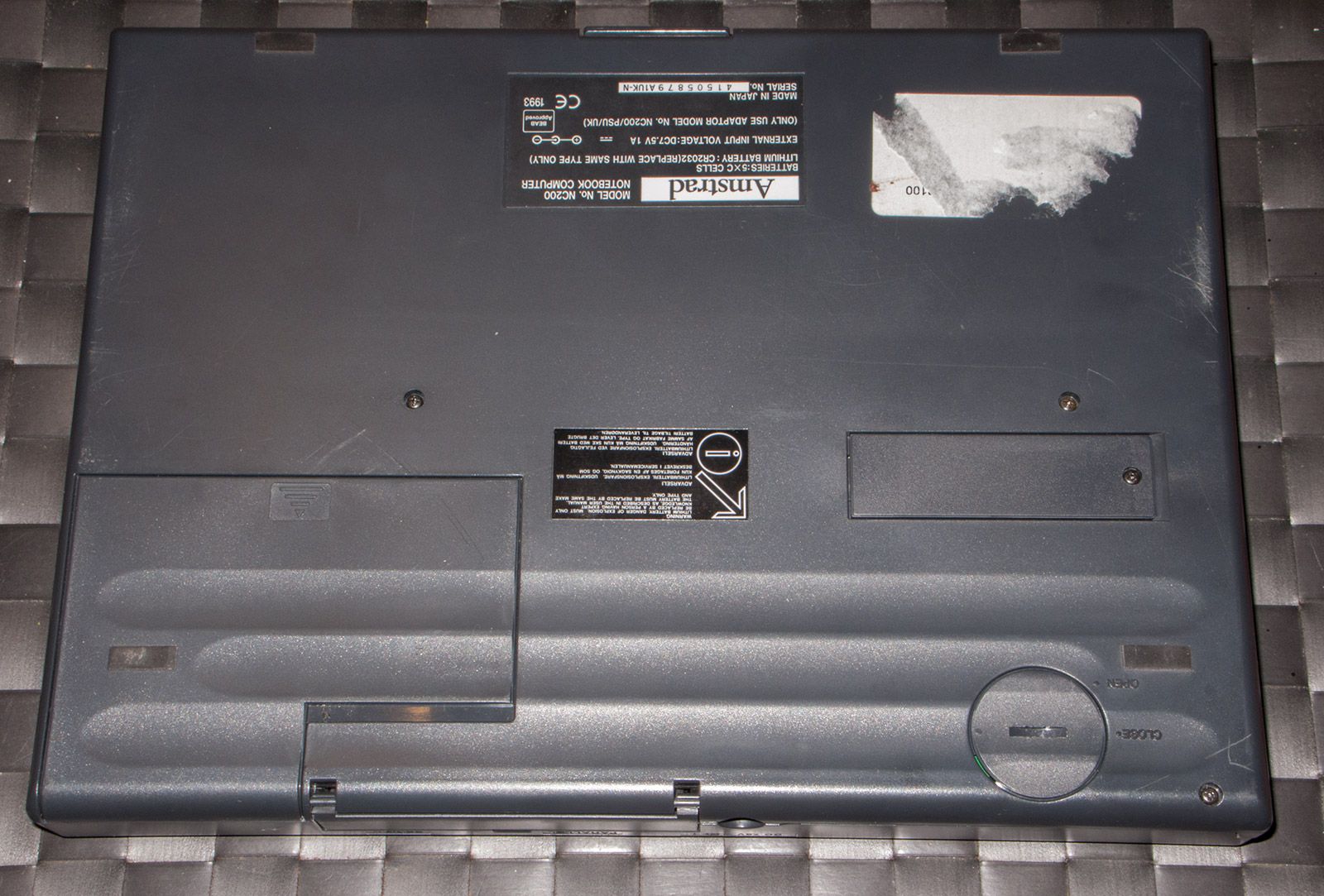
Once you remove the upper part of the case you have to disconnect the cables that go to the screen. Be careful, the white one is short.
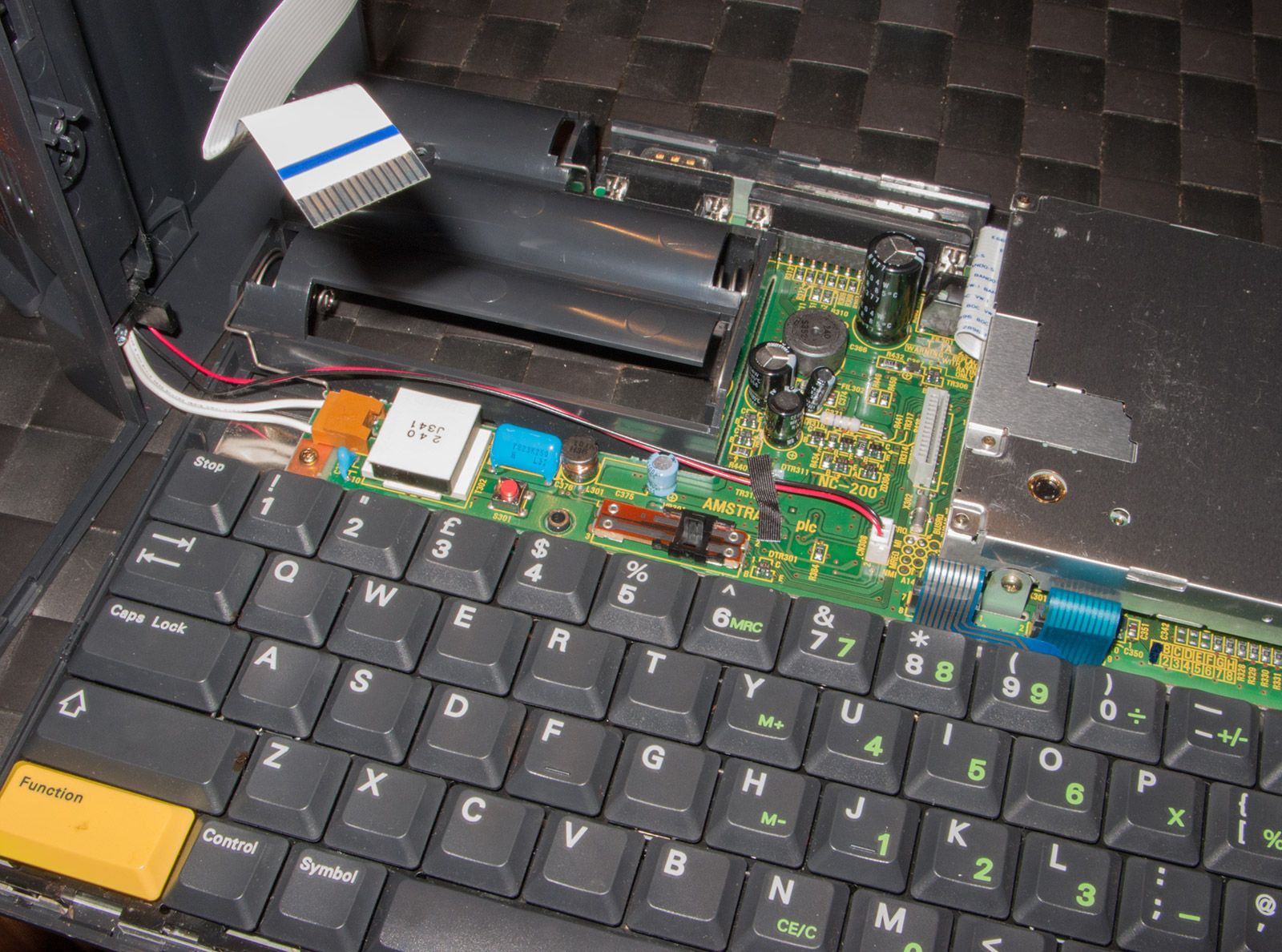
It is time to take out the floppy drive, the motherboard and the keyboard. There are a few screws holding everything in place.
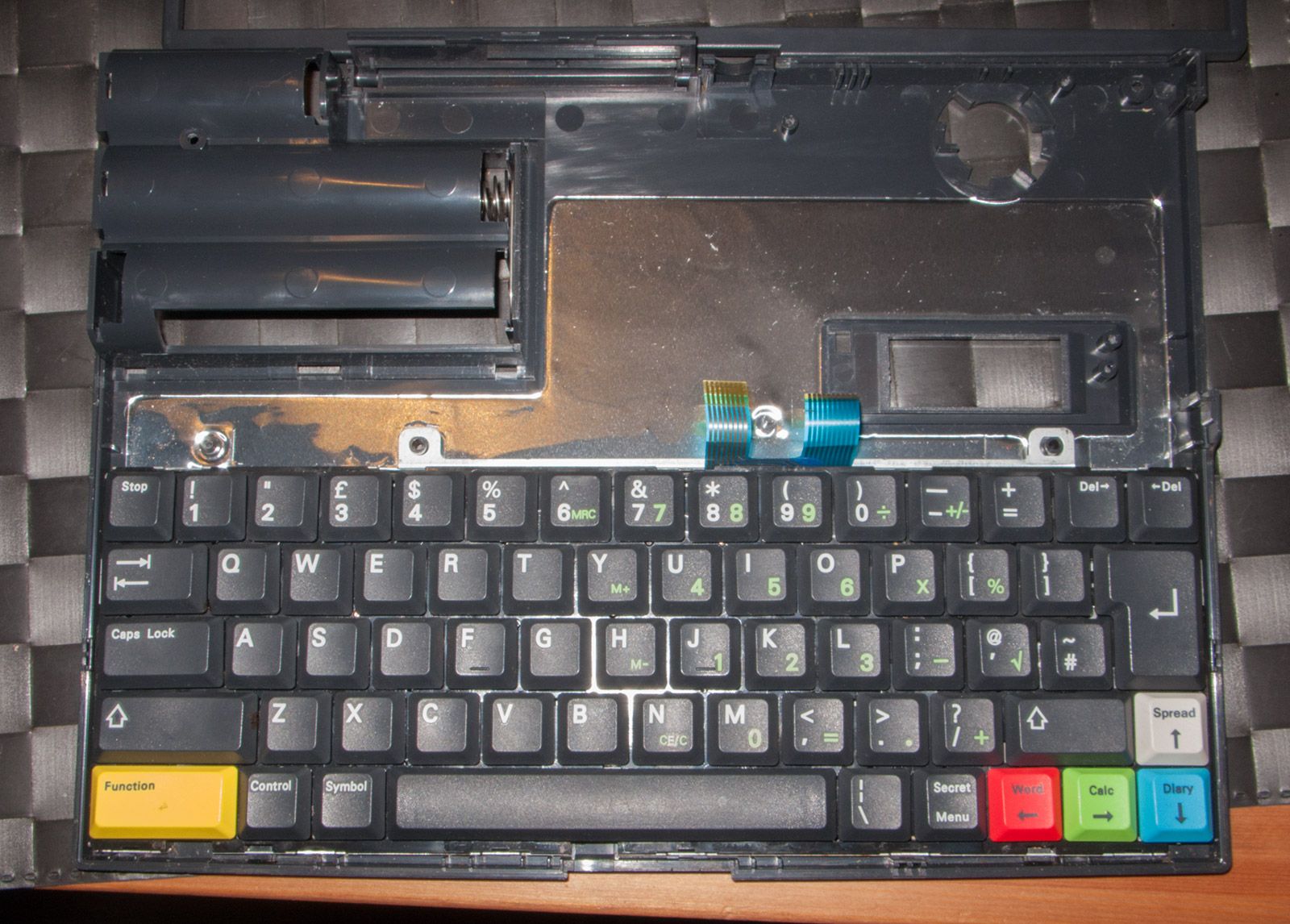
The external structure of the keyboard is similar to the one found in many other Amstrad. To open it you need to remove 3 screws and release a few clips.
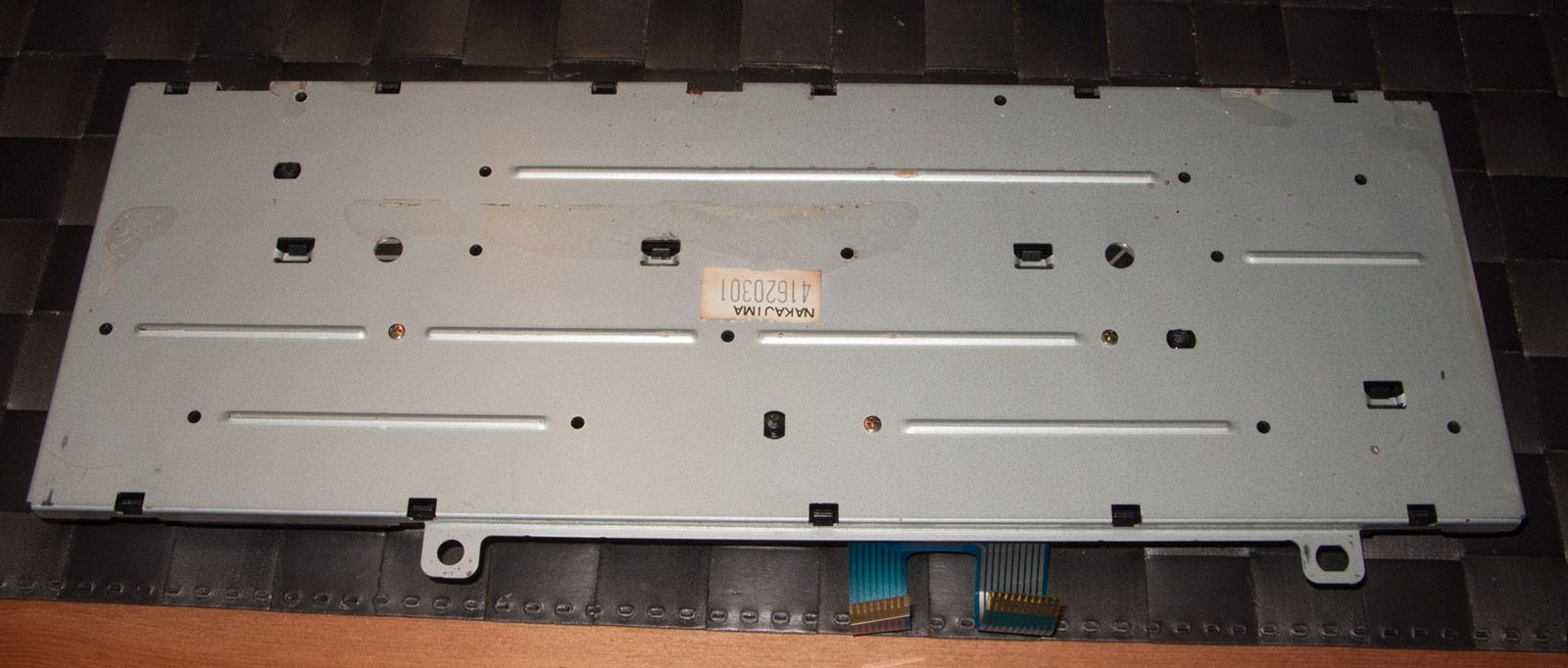
In my case the membrane was extremely dirty. It seems that some liquid fell onto the keyboard in the past and entered between the two layers sticking them together. I used isopropanol to dissolve the crap and give it a good clean. Luckily, the solvent did not affect the fused plastic that joins the two layers, otherwise it would have been necessary to re-glue them. It seems obvious but when you see that two layers of a membrane are stuck by something that dried between them you should never try to separate them by pulling. There is very decent chance to damage the tracks.
Below is how it looks after the cleaning. Some of the silver is darker because there was some oxidation going on, but this does not affect conductivity or makes the tracks more prone to break. The oxide layer is extremely thin. In case of broken or corroded tracks it would have been necessary to reconstruct them with silver paint. This can happen if acid liquids, like orange juice, are spilled on the machine.
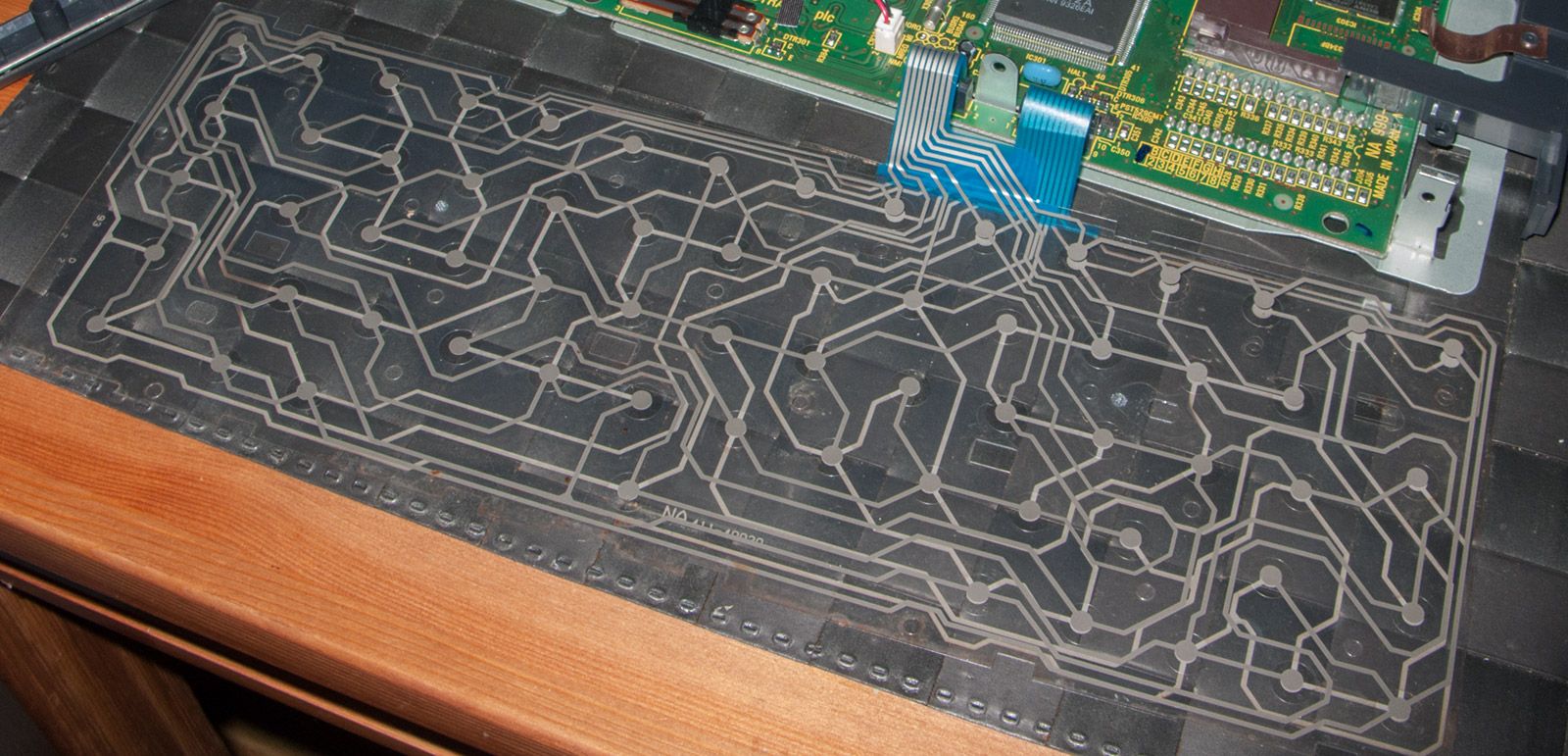
Now onto the keyboard itself. There was nothing important here. The only thing that was out of place was the clip that makes the SPACE bar to go down uniformly when you press it. I put it back in place and cleaned the keyboard with lots of KH7 and water. Everything is made of plastic besides the metal clips, so no worries about oxidation. After cleaning you just need to manually dry the clips and let the rest dry by itself. If you do not dry them it is fine too, but I like to do it.
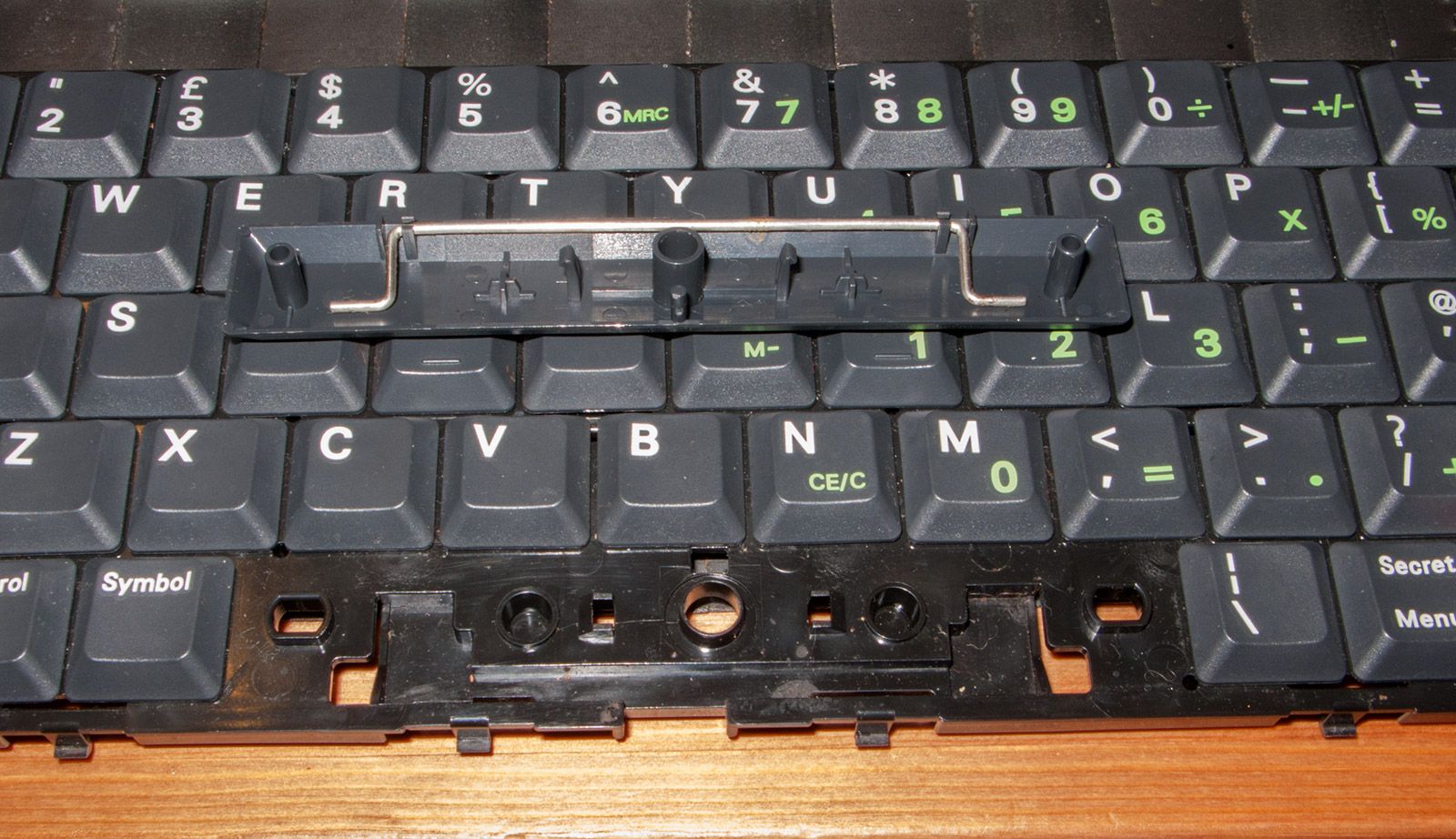
Time to reassemble the keyboard. We do not have nice springs, like in the CPC range, but rubber domes with the same function. I do not like this solution because it changes the keyboard feeling and the domes look a bit on the fragile side, but I must say that they are still in perfect condition. Maybe Amstrad engineers were not so wrong after all.
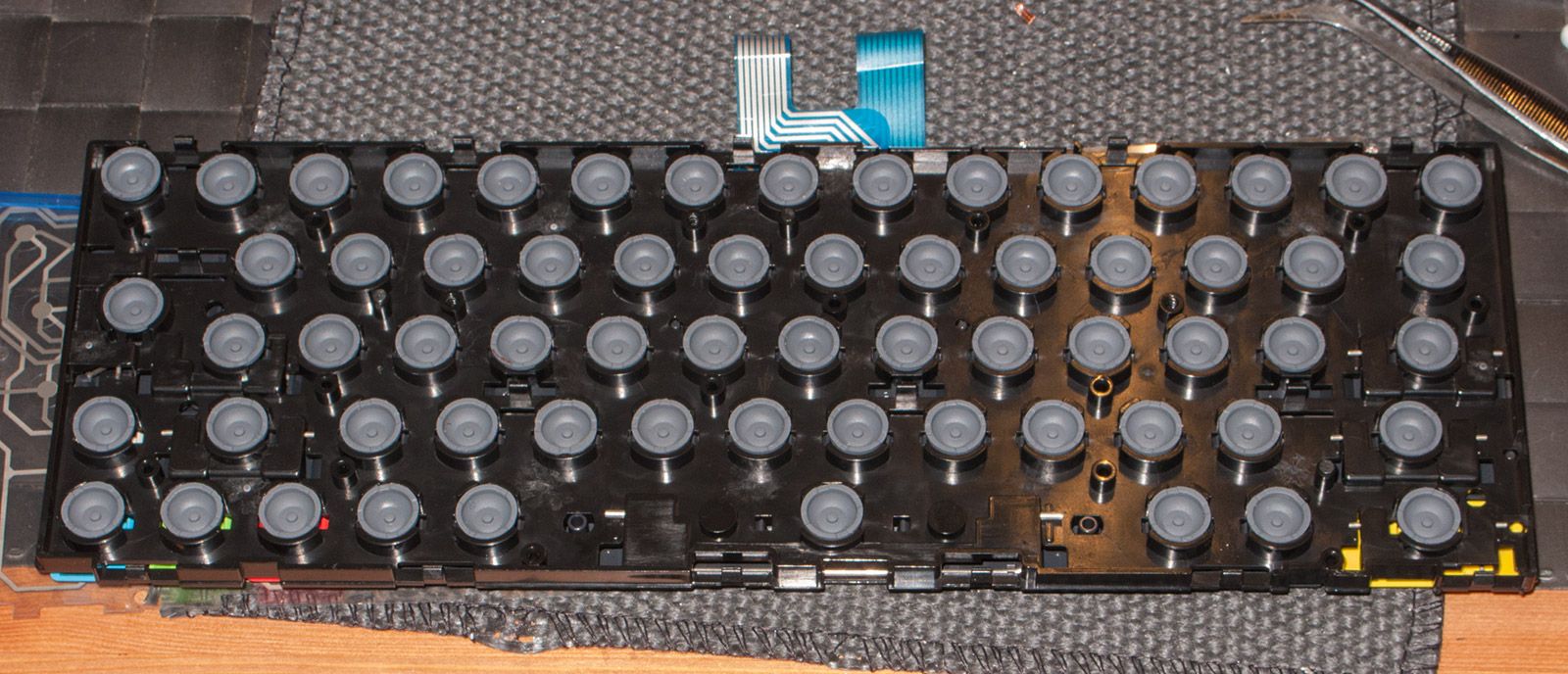
The next thing was the backlight. The NC200 is reported to have a bright backlight that, in my case, was extremely dim. I asked Bryce about the backlight on his unit but, before he could check, I decided to replace the caps in the board and the light came back clear and strong. It seems that one or more of them went bad over time and this was giving the circuit a hard time. Replacing the caps is easy and their values completely common (sorry, I trashed the note where I wrote them). It should be a relatively simple task if you have some soldering skills but there is a very important thing to remember: some of them NEED to be low profile. Look at the picture below, it is the mainboard with the new caps. THE ONES MARKED WITH RED ARROWS NEED TO BE SHORT, otherwise you will not be able to re-install the floppy drive or close the case.
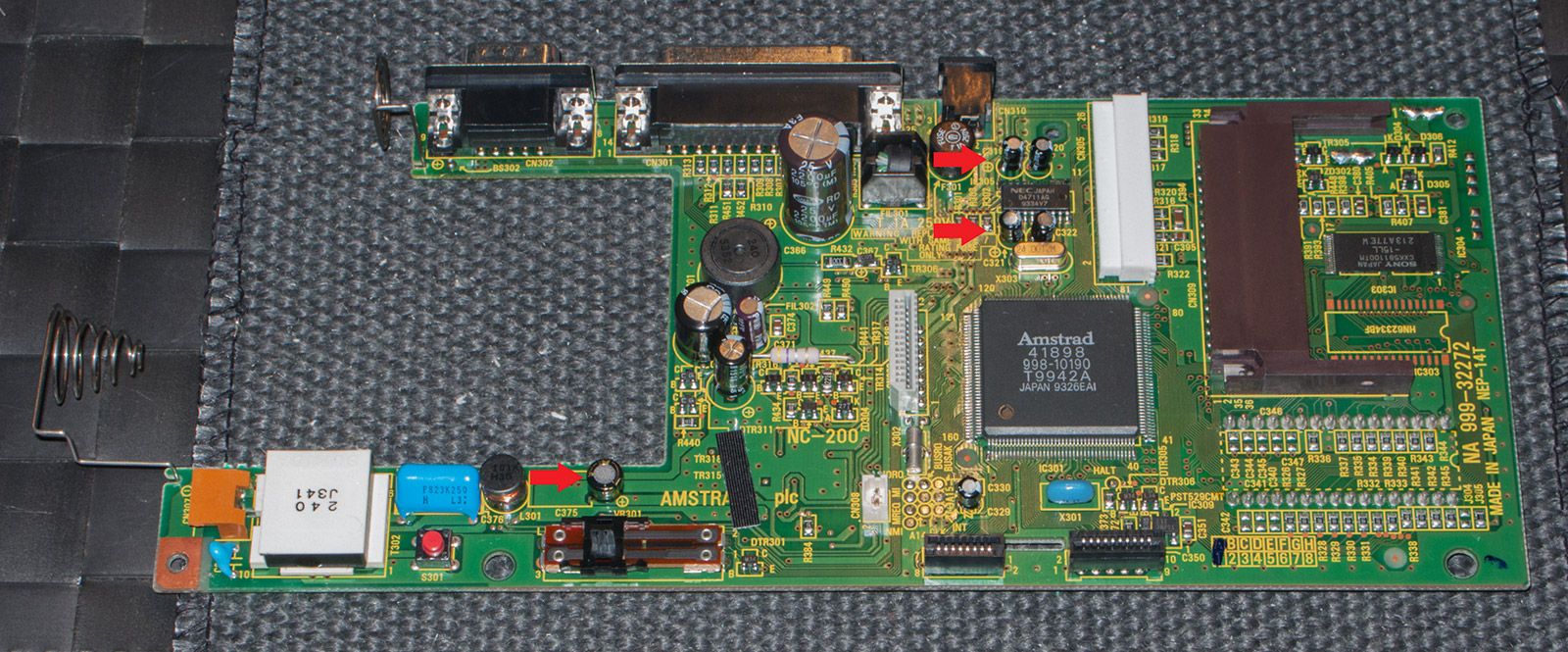
Finally, onto the floppy drive. It is a very special model (Citizen V1DC-65B) or, at least, this is the first time I come across it. When I tried to format a floppy in the hope that it would work I found that it was not OK. Sometimes it was able to read something but most of the time you could hear the motor making noises and struggling with the old belt. Therefore, I opened it to see if it was possible to install a new one.
The first thing is to unscrew the upper shield to have access to the guts. It is not necessary to remove the frontal plastic bezel at all for this.
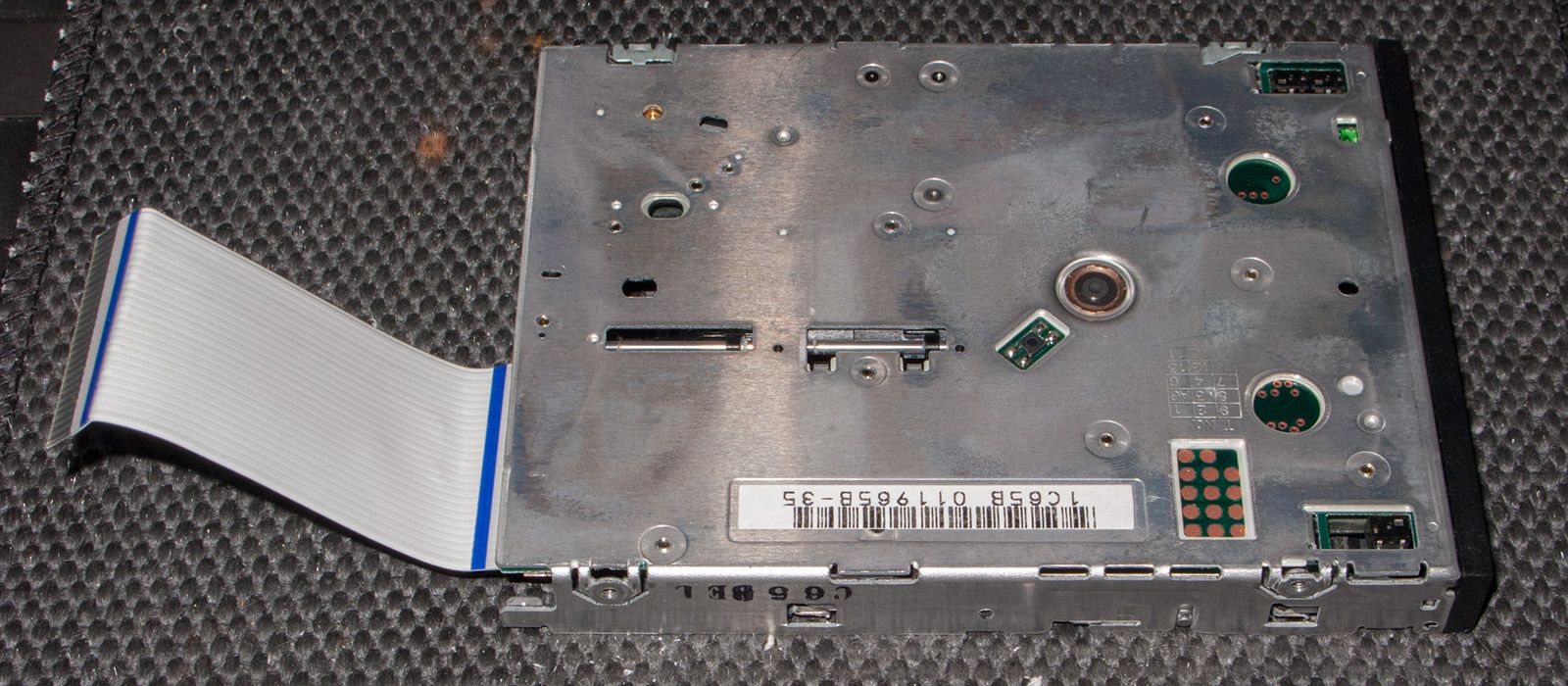
The second thing you need to do is to lift the head of the drive and remove the floppy support. It is very easy, just pull it back a little bit and it will come out. The springs that keep the floppy in place are also part of a mechanism that allow easy removal of the whole support. Funnily enough, the drive has a LED but you cannot see it when the machine is working because there is no hole in the bezel. It is very important not to forget to lift the head (not yours, the black plastic thing in the middle of the drive). Otherwise you could easily damage it and it is very delicate.
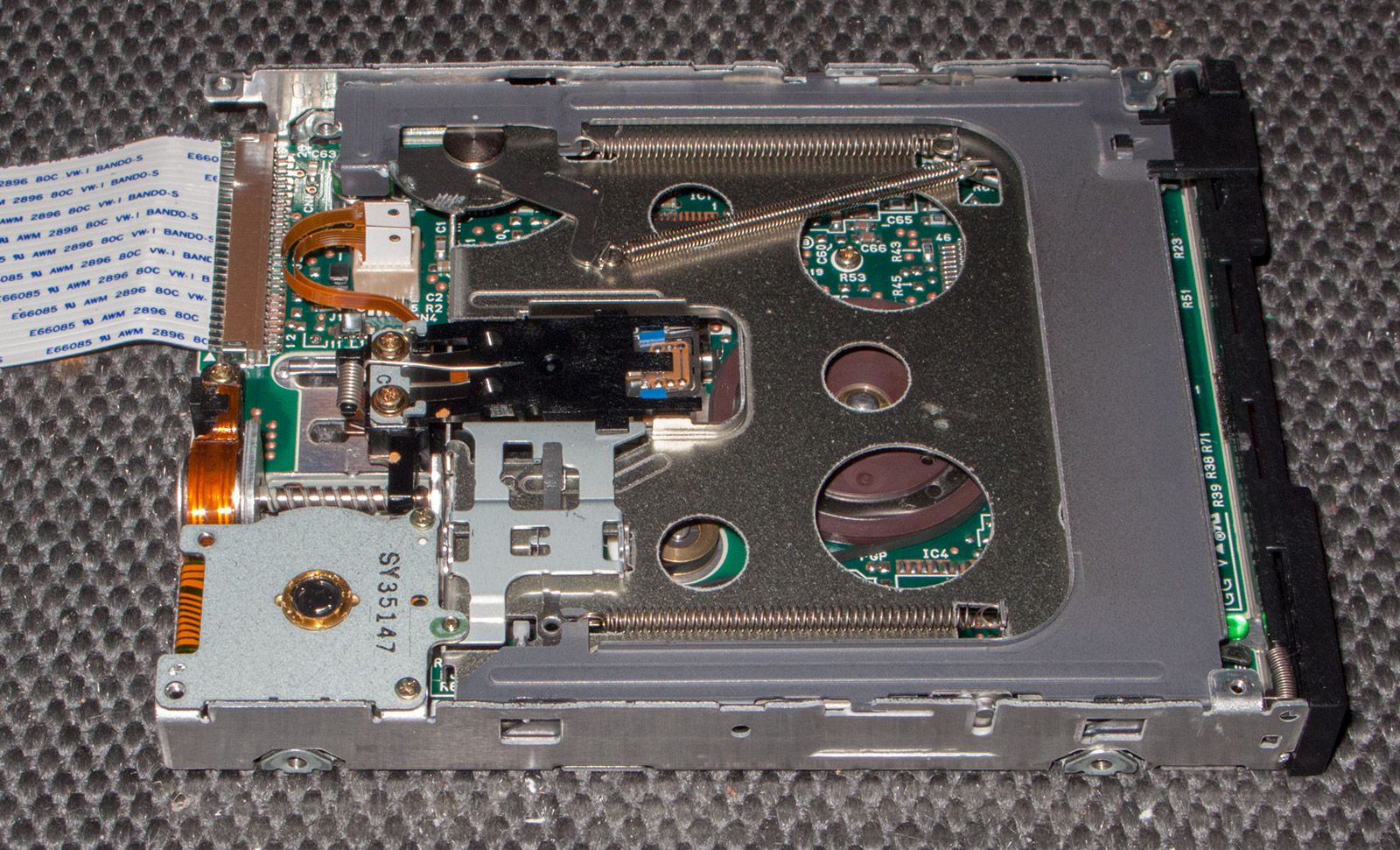
And here is the inner part of the drive once you remove the screws of the motor. The belt was in pretty bad condition and not elastic anymore.
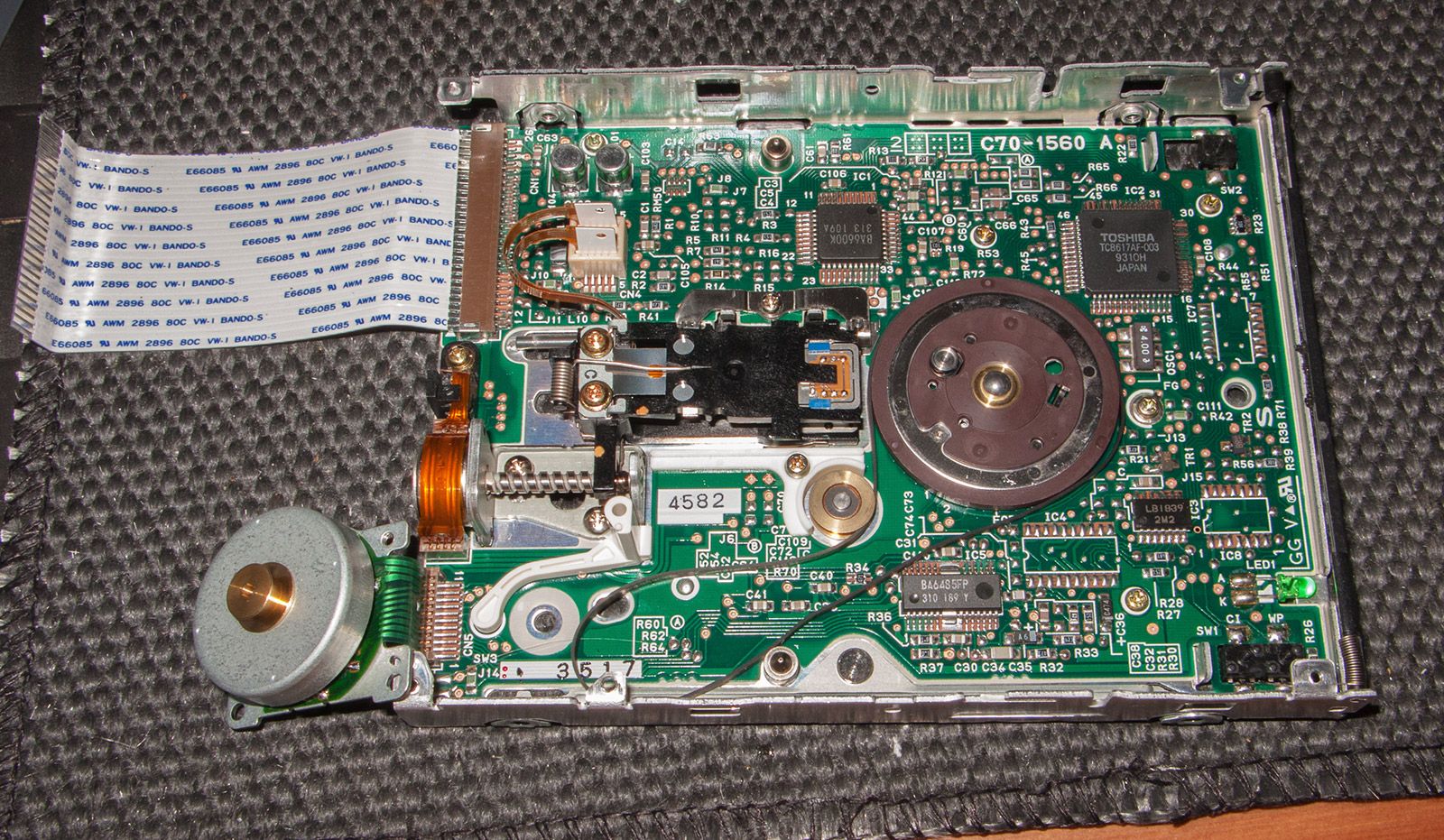
The belt needs to be 2 mm wide, otherwise it will not fit into the grooves of the guide bushings. There is more tolerance with the thickness. The original is 2 mm wide and something like 0.5 mm thick, but the substitution belt is 2 mm wide and 2 mm thick. Regarding the diameter, something around 70 mm should work. You do not want it much smaller because then it would be necessary to overstretch the rubber and that would not be good. Luckily, although the new belt is thicker it does not touch anything in the board.

To assemble the drive you need to follow the same steps but in reverse order. Remember to lift the head to put back the floppy support! Once it was ready I formatted a few discs, saved several files and loaded them back. Everything was fine.

The next step was to detail the plastic case a little bit and reassemble the NC200. Then I did some more testing before closing the machine for real. Before you do this remember to align the slider that adjusts the contrast with the variable resistor on the board, otherwise you may have to open it again.
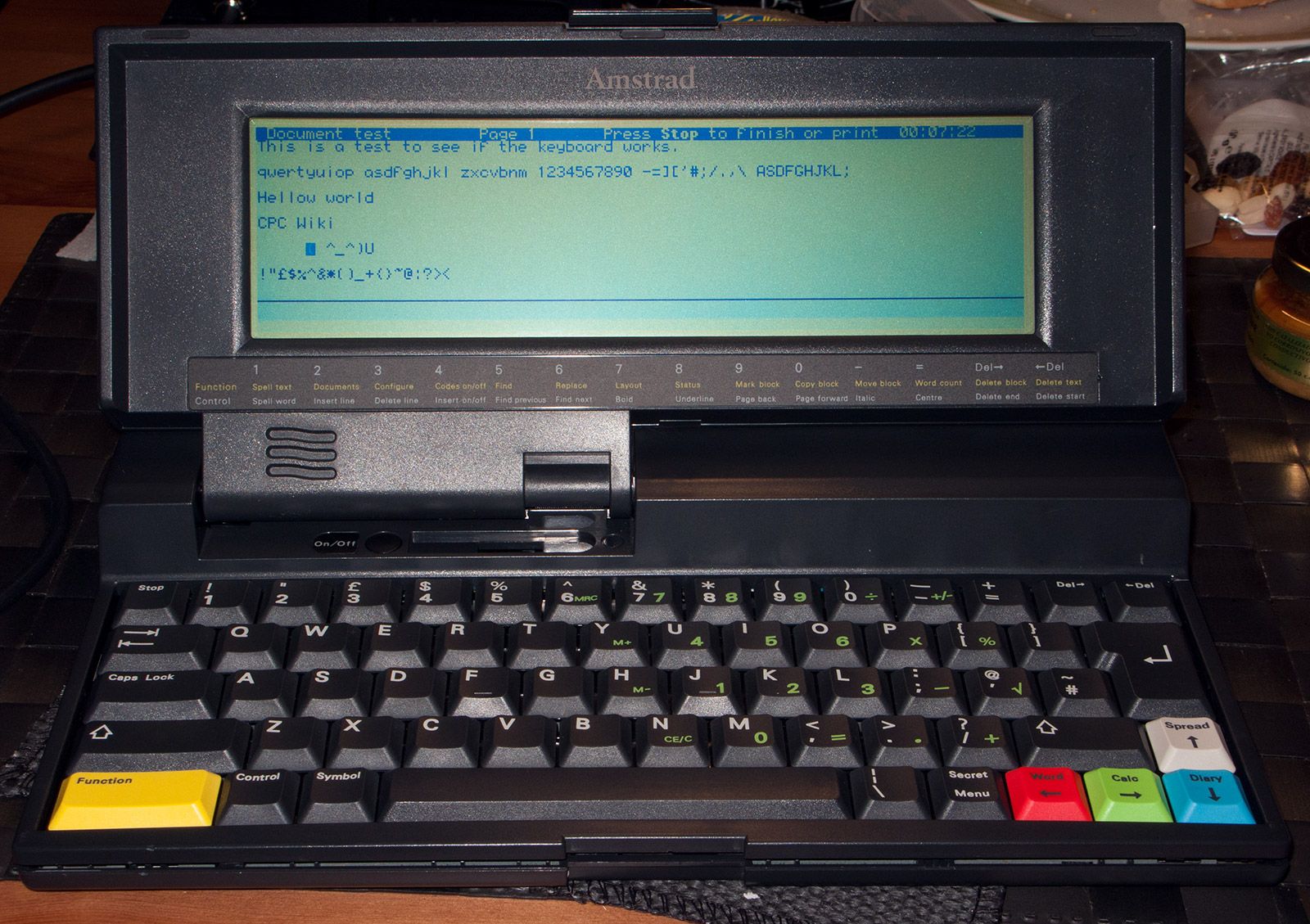
And here it is, happy and working! There was nothing extremely wrong with it, but quite a few little things.
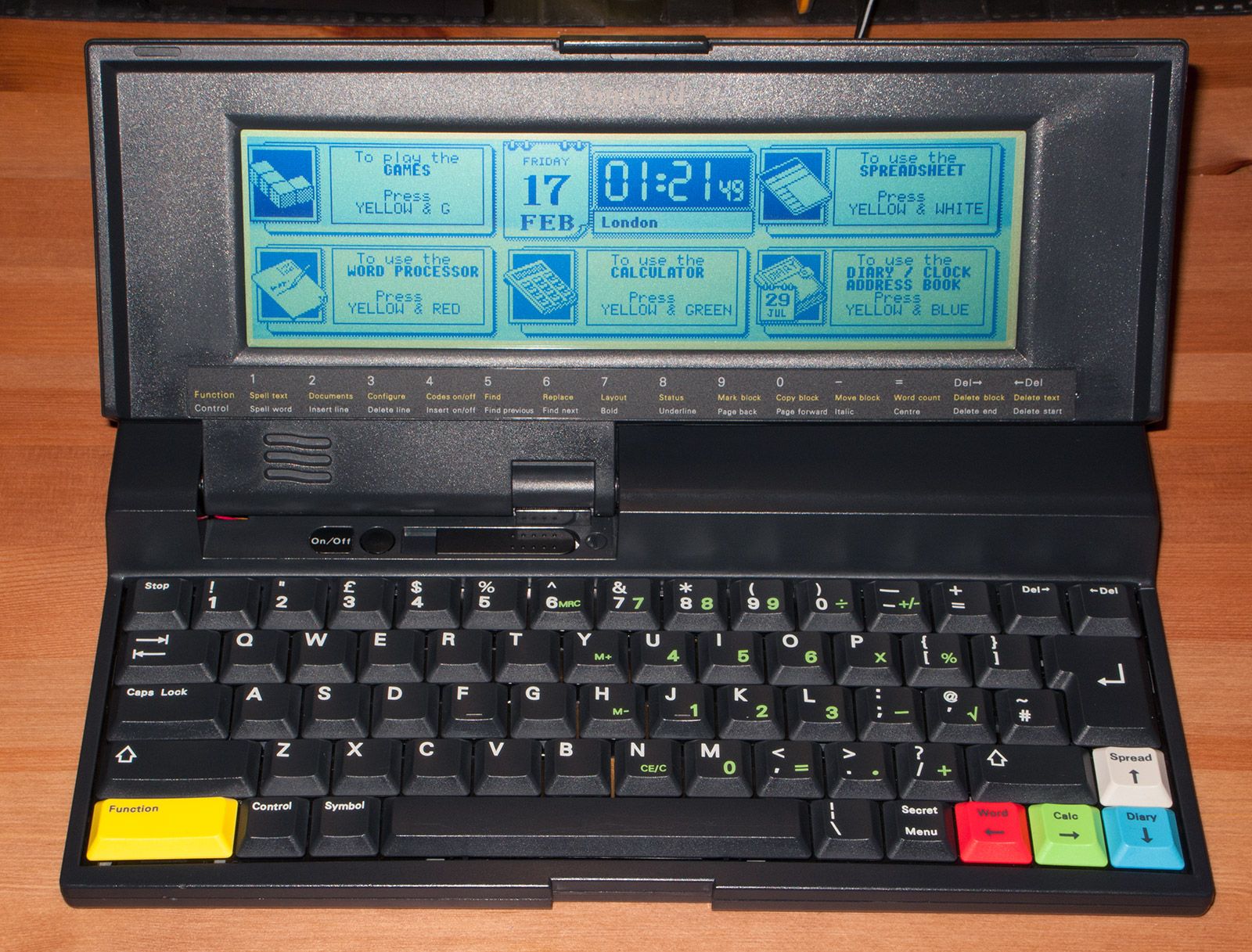
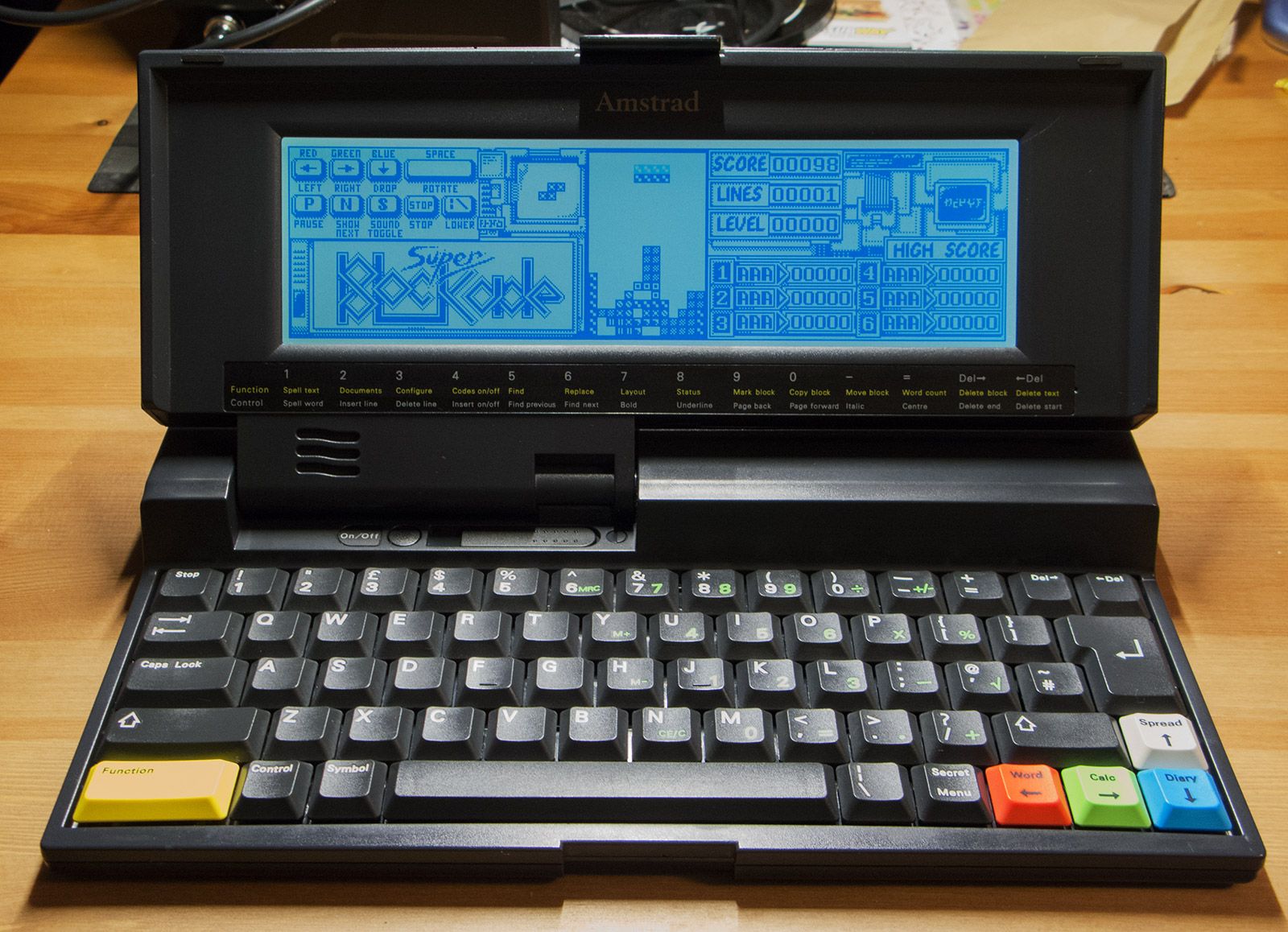
As I said at the beginning, there is something worth mentioning regarding the plastic used to make this computer. I found it not particularly robust when compared to a regular Amstrad CPC or Plus. My NC200 had a crack near the keyboard that I am sure appeared when somebody tried to open it in the past. There are also some small marks in the case because the same or other person introduced something in the gaps between the two shells, probably metallic, to separate them. I repaired the crack with epoxy and it is fine now but you really want to be careful when opening the laptop. What I did was to fill it with resin and add some extra epoxy around. It is all in the inner part of the shell and, therefore, not visible from the outside.
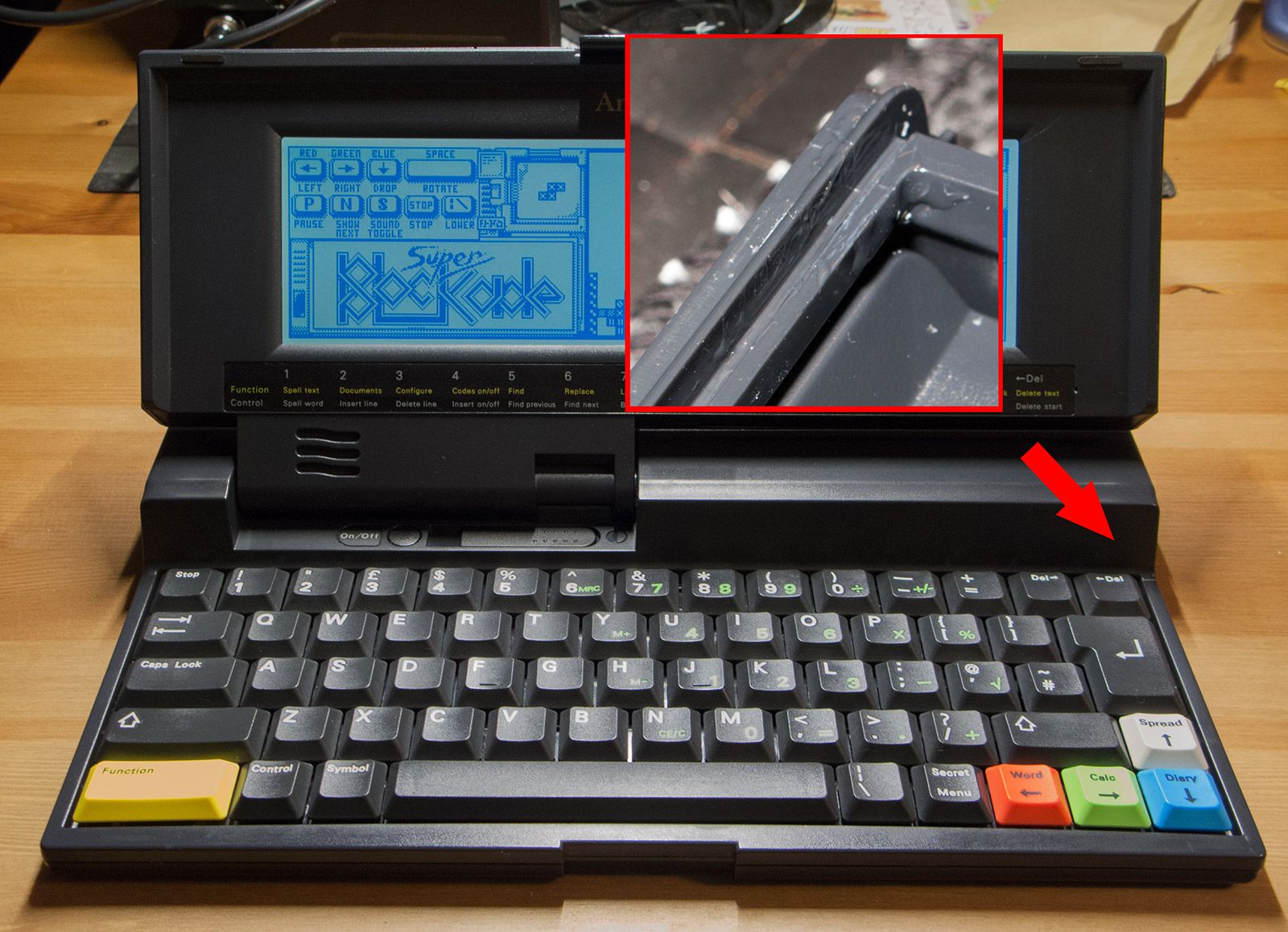
There is still a final tip: the NC200 needs 7.5V and 1A to run. There are many PSUs suitable for it but the polarity is reversed when compared to the CPC range. That is, outside you have the positive and inside the negative. This is written in the case of the machine but many people have burnt the internal fuse because of this. Keep it in mind and remember that if somebody sells on e-bay a not working unit this is possibly the case and most likely it can be repaired.
BDCIron is testing Amstrad CPC games : Great Gurianos and Addams Family, and also a demo : Big'O'Full demo.
See the previous news for more details about Great Gurianos.
In his latest video (24th February) BDCIron is testing the following games :
I didnt know this game, but the Amstrad CPC and C64 mixed music of Great Gurianos by Vincent GR is nice.
There is a longplay of Great Gurianos by Amstrad Maniaque on Youtube.
The game was one of the first written by David Perry. It's a port of an arcade game by Taito : Gladiators. It was out in 1987 by Elite Systems.
Eight bit Magazine isnt the only one to be on Kickstarter, there is also Colour Personal Computing Fanzine issue 2 by James Ford.
This issue has 40 pages of Amstrad CPC content :
Amstrad Dreams by DATAStream is a music album of 5 tunes written by Martyn Stonehouse.
There are 6 tunes on Bandcamp.
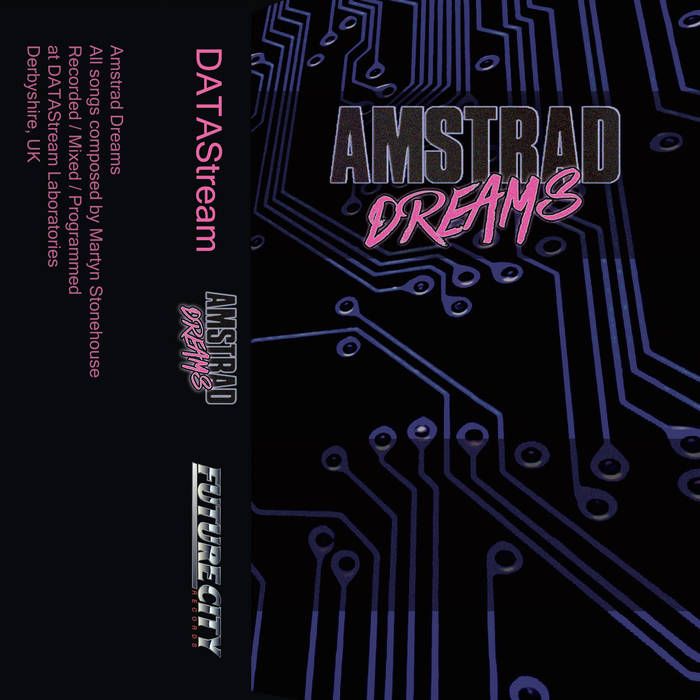
A new version of the desktop JavaCPC is available. It's an Amstrad CPC(+) emulator written in Java by Markus Hohmann (DevilMarkus).
Jose Javier Garcia Aranda has written a new version of 8BP v28 (8bits de poder : 8bits of power), a RSX library for writing Amstrad CPC games in basic (26 Kb max). You can download 8bp on github.
A preview of a platform game with 8bp is available on Youtube
For more news, Go to home page